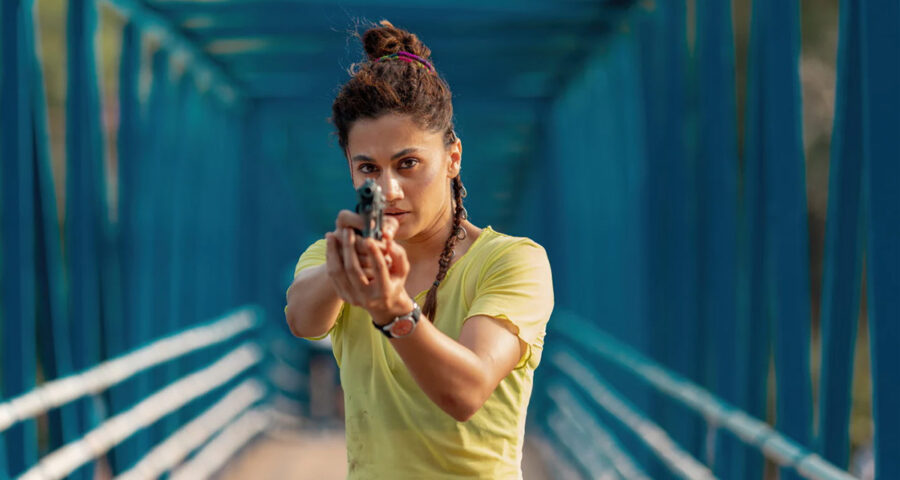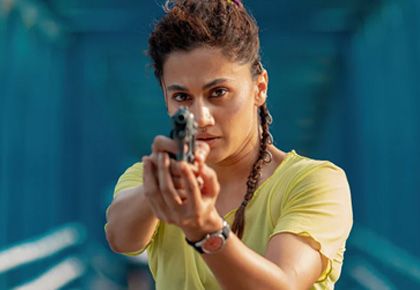The simplicity of the model that was the original, which allowed it to glide with grace, has been foregone, observes Rohit Sathish Nair.
Looop Lapeta owes its existence to the 1998 German hit Run Lola Run as well as the Satyavan Savitri myth, and so some expected to see the changes from the original film’s themes of ‘free will’ and ‘determinism’ when karma is added into the mix.
A few days after watching the original and hours before I started watching the remake, a question that bubbled up in me was: Now that the actions might have moral weight too, would the movie now also get to be an exploration on ‘movie morality’ and similar conventions, or at least a document of the same, just like the first three Tarantino movies were, with their somewhat rudimentary karmic codes? (Run Lola Run had no time to spare for passing judgments)
Looop Lapeta, in some ways, feels like an inversion of Run Lola Run.
The makers have made the smart choice of juggling some of the occurrences in each of the three but there are also instances of inversion: The original started with quotes by T S Eliot and Sepp Herberger, and with questions like ‘Who are we?’ set to visuals of a crowd.
Looop Lapeta, on the other hand, opens cheekily with a shot of one of those ‘go-get-em’ WhatsApp forwards but then the inversion becomes more apparent: Run Lola Run hit the ground running, introducing its characters through snapshots and setting its terms in no time (a stolen bike, a misplaced bag of money), while Looop Lapeta starts with a backstory, which would have gone down easier if it wasn’t for the quippy narration.
But then we get to the main diversion Looop Lapeta takes, and by extension, its main issue.
What made Run Lola Run something more than just a post-Groundhog Day, post-Pulp Fiction movie, was its visual syntax, which now in hindsight, seems very well-modulated.
There was something symphonic about the length and movement of shots changed in relation with each situation, and that made the film seem fractured yet fluid, one of a piece. The final breathtaking effect felt cumulative (perhaps even impressionistic, if I may lapse into hyperbole)
Looop Lapeta makes many updates to the visual scheme: While Lola with her red hair darted amongst dull, faded, muted colours, here the red comes with the counterpart of green, a lot of it: Bathroom walls, palms, coconut trees, even an unwieldy metaphor of a green butterfly.
We also get other colours jostling for attention, like blue, yellow, orange and pink.
In the form of more over-elaboration, we get too many single shots and inserts of each character and props, most of them through a wide-angle lens, some of them sped up, some of them slowed down for emphasis (The woo-woos of the original must have seemed fresh back then, and today, make you feel oddly nostalgic, but in a post-‘visual information explosion’ age, this movie’s effects feel exhausting).
The makers choose to enshrine every moment and every frame, and conversely, most moments and micro-events become parodies of themselves (This makes us understand how much the original respected momentum).
This leads to a sense of danger, and a sense of weight of consequence, leaking out of the proceedings, as opposed to the original, which had its sense of danger implicit in every moment, where anything could happen. This is all the more perplexing when you see that this movie considered to explore how the morality of each action could have added consequences.
This issue starts to rear its head right from the first act, which when padded with backstory and setup, only gets over by the time the original had gone through its first two iterations.
We also get added subplots involving a wedding (more about it later) and a jewellery store (standing in for the supermarket in the original that the boyfriend character is looking to rob) that is under threat of being robbed by its owner’s sons, and these instead of deepening the movie’s points on karma and consequence, both complicate the plot and don’t let the movie sprint to glory.
The simplicity of the model that was the original, which allowed it to glide with grace, has been foregone. Also, in trying to enshrine the serious moments where blood is shed and egos wounded, and underlining the silly ones and milking them dry for humour, this film fails to achieve the mix of tones that the original seemed to attain with ease.
Things begin to look up once we get to the second round, where we see that the protagonist Savina (Taapsee Pannu) is aware of what happened and went wrong in the previous iteration, and the movie gets to begin to genuinely play with her awareness of her situation.
The aforementioned issue of there being no genuine sense of danger, also particularly affects the third act, where Savina’s well-laid-out game-plan ensures that in spite of the convolutions involving Satya (Tahir Raj Bhasin), the jewellery store owner and his sons, you are fairly certain of the impending good ending.
This was a challenge that the original seemed to have too, and there we saw how Lola’s perfected plan still led to others (at least some of whom were unhurt in the previous iterations) undergoing unpleasant incidents (a feathery touch which still has more profundity than most incidents in this film, even without the added mythic and karmic connotations).
The choppiness of the visual style brings about both triumphs and casualties in the performance department.
On the side of the former, we have Taapsee Pannu who is photographed smartly such as height and vitality get projected on her, and Dibyendu Bhattacharya as Satya’s boss Victor, who tacks on to the most transparent, literal sentences the phrase ‘If you know what I mean’ and yet, adds to acts like marinating a turkey, a very eerie, icky suggestiveness.
Tahir Raj Bhasin, on the other hand, doesn’t get to hit sustained rhythms as a slapstick performer, and the over-deliberate style is also oppressive on the comic roles, which don’t give enough leeway for the actors to shape and land their performance.
The truest performance, the best shot and the most memorable scene of the movie come thanks to Shreya Dhanwanthary, playing Julia, who is confused about choosing between her fiancé Robert and her boyfriend Jacob.
It is an unbroken shot, perhaps the longest shot of the movie, which has Julia setting off on a monologue about her dilemma (Dhanwanthary concentrates all of the sincerity that marked her performance as the underdog in Scam 1992 into this shot, and comes up trumps), and this segment becomes the tall drink of water that seems to clear almost all the hiccups of the movie.
One can feel the effect that this segment has on the rest of the movie, which automatically comes across as more relaxed.
The scene is also notable for the solution that Savina puts forward to Julia, and her reasons for it — it extends the bounds of both the characters in the scene.
Maybe it is something of a paradox, that a movie whose USP is ‘playing with time’, achieves its best effect in real time, sans manipulation, sans expansion or contraction, sans sculpting.
Source: Read Full Article



